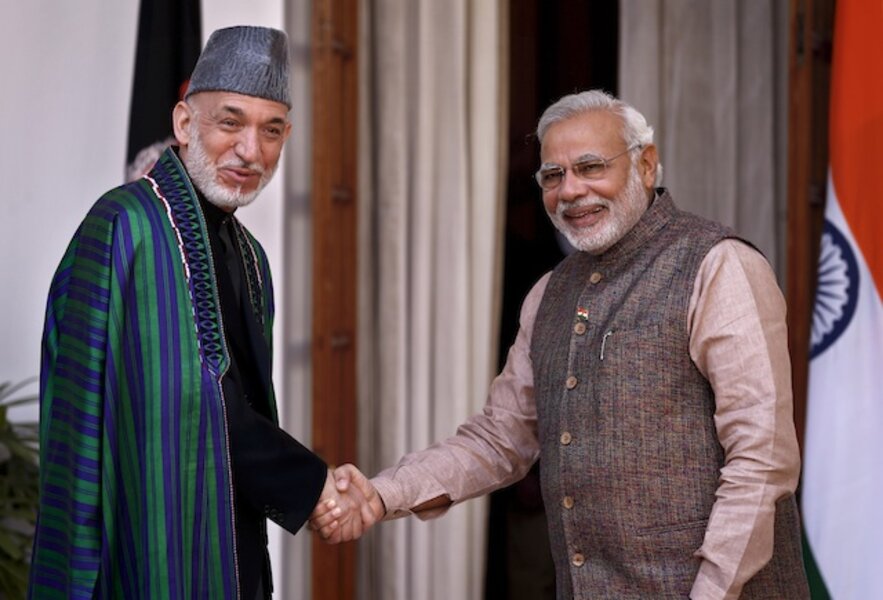With US leaving, is Afghanistan turning to India?
Loading...
| New Delhi, India
When Afghanistan President Hamid Karzai attended the inauguration of India's new prime minister last week, he brought an impressive wish list: battle tanks, field guns, trucks, and military helicopters.
Mr. Karzai's requests coincides with a growing debate within Indian government and military circles whether to ramp up military aid to Afghanistan, a move that risks antagonizing neighbor Pakistan, but that could pay off if militant groups antagonistic to India are kept from power, diplomatic and military sources say. The attack on the Indian consulate in Afghanistan's Herat Province late last month adds impetus to the debate.
“We can’t afford to let Afghanistan fall again in wrong hands,” says G. Parthasarathy, a former Indian high commissioner to Pakistan now based in New Delhi. “India has to shift its strategic thinking, from economic development to strengthening of the Afghan National Army.”
Over the past decade, India has provided limited military aid to Afghanistan, mainly by training about 1,400 Afghan officers and members of its special forces. But now that the bulk of US and other NATO troops are leaving by the end of this year, there are some indications that India is reevaluating its stance in order to prevent Afghanistan from slipping back into the hands of the Taliban and other Islamist groups that are hostile to India.
Several Indian diplomats have been targeted in militant attacks in recent years, most recently on May 23 when the Indian consulate in Herat Province was attacked by at least three heavily-armed insurgents. The diplomatic staff escaped unharmed and the attackers were killed by Afghan security forces, local police said.
According to a recent Reuters report, India has agreed to pay Russia to supply smaller arms such as light infantry and mortars to the Afghan military. The agreement, as reported, could eventually involve the transfer of heavy artillery, tanks and even combat helicopters that the Afghans have been asking India for since last year. Indian officials in New Delhi did not confirm the report.
During his visit last week, Karzai, who is in the final days of his 10-years in office, gave an interview on Indian television, suggested that he was making headway with requests initially made last summer to purchase spare military equipment: “We’ve given a weapons wish list to the Indian government," Karzai told the Indian TV station, Headlines Today. “Some have been accepted and delivered to us and we are confident Prime Minister Modi will consider [the rest] favorably." Neither the Indian or Afghanistan government makes public the figures for military aid between the countries.
India, the world's largest arms importer, has a limited domestic weapons industry. The arms Afghanistan wants are old or extra battle tanks, bridge-laying equipment, trucks, field guns, military helicopters for the Afghan army, and equipment to counter homemade bombs, the latter being the biggest killer of soldiers in Afghanistan.
'Soft power' ties
India shares traditionally warm ties with Afghanistan. After shunning Afghanistan during the Taliban regime, India become a friend and a strategic partner to the Afghan government. Indian culture, including Bollywood, as its film industry is known, is hugely popular in Afghanistan and India sees an opportunity to win economic influence, boost security, and gain a trade link to Central Asia through Afghanistan.
Over the past decade, India became one of the top five donors of humanitarian aid to Afghanistan, according to Afghan government figures. It has invested more than $2 billion in the country, including building the Afghan National Parliament in Kabul, and power lines from Uzbekistan to Kabul. India also expanded its people-to-people contacts, giving 1,500 scholarships annually for Afghans to study in India. This year expanded the program to include 614 postgraduate fellowships in agriculture.
Much in the India-Afghanistan relationship, including military aid, will depend on new leadership. Afghanistan holds a run-off election for president on June 14. Abdullah Abdullah, a former leader in the anti-Taliban Northern Alliance, the front-runner in the presidential polls is considered to be a supporter of India. His family lived in New Delhi during Taliban rule in the 1990s.
In the interim, Indian officials have pledged that the attack in Herat will not deter their engagement with Afghanistan.
“The attack only strengthened our resolve to work together with Afghanistan,” India’s Foreign Secretary Sujatha Singh told reporters in New Delhi after President Karzai’s met with Prime Minister Modi. “We expect this cooperation to increase in the days to come.”







